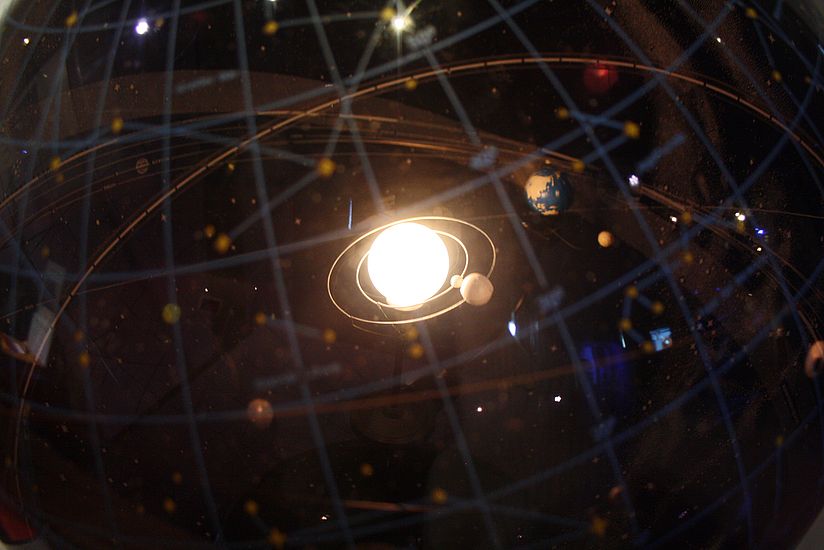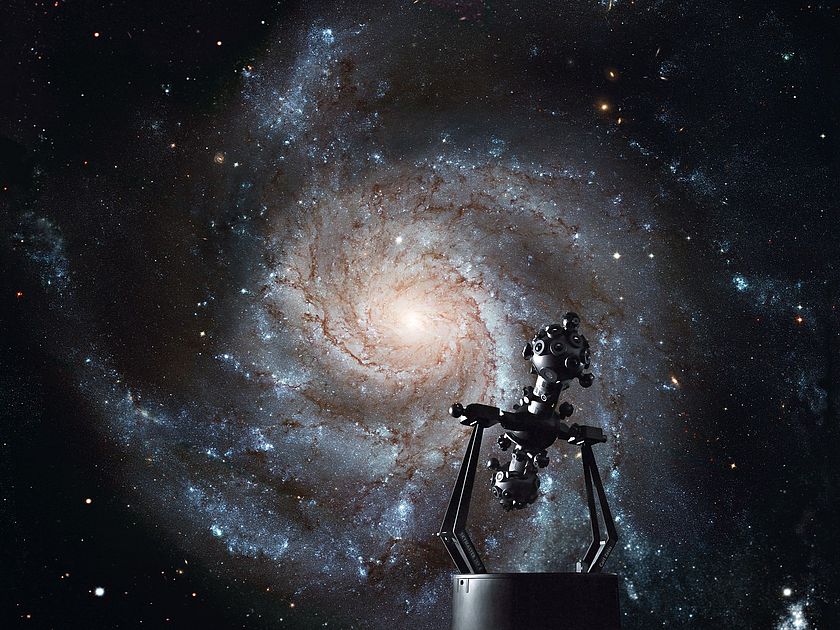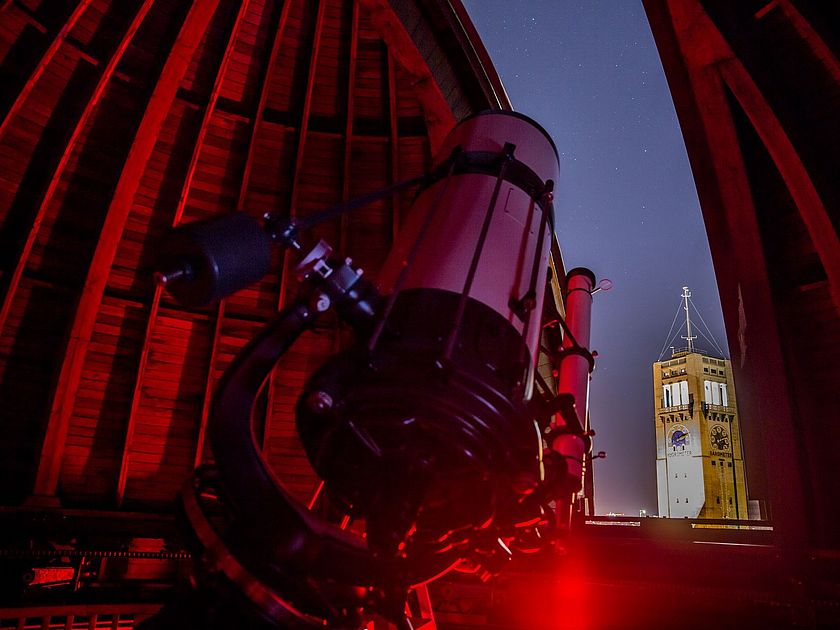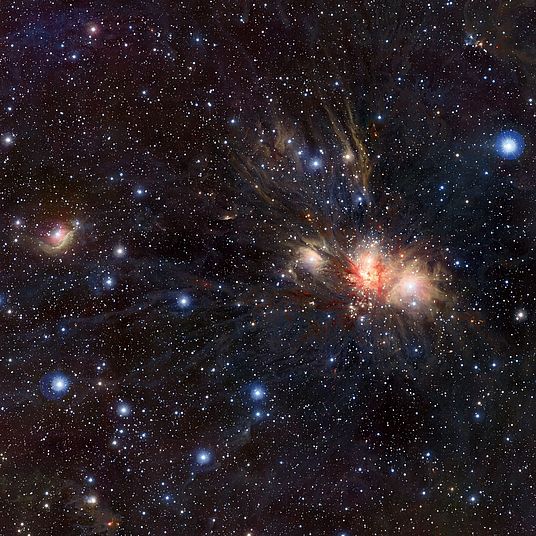
Photo: Deutsches Museum
Astronomy
Astronomy Exhibition Themes
The universe across 1,100 sqm – experience its infinite expanses over three levels. This exhibition explores the following topics and contents:
Model of Uraniborg with the observatory of Danish astronomer Tycho Brahe (1546–1601). He did not have a telescope for his measurements. Photo: Deutsches Museum | Christian Illing
The Universe and the Night Sky
This exhibition begins with an overview of the structure of the universe. Our Earth is one of eight planets in the solar system (the ninth planet Pluto was downgraded to a dwarf planet in 2006). The sun is a star. It joins billions of other stars to form a galaxy – our Milky Way. And together with billions of other galaxies, this is a part of even larger structures in space.
The distances in the universe are so vast that they cannot be described by the units of length that are commonly used on the Earth. That’s why astronomers use their own measurements of length, including the light year.
What is the structure of the universe? This area deals with the appearance of the night sky. Light from the stars reaches us from different directions and distances with various levels of intensity. Stars have a particular position, brightness and distance from the Earth. Astrometry, the measurement of stars’ positions and the various movements that take place in the sky, are explained here in detail. Impressive exhibits include the large mural quadrant and models of the observatories of astronomers Tycho Brahe and Johannes Hevelius from the 17th century.
Engineering model of the ROSAT X-ray satellite in its original size. Many sources of X-rays were observed in the sky with these satellites from 1990 until 1999. Photo: Deutsches Museum | Christian Illing
Astrophysics and Astronomical Instruments
In the mid-19th century, astronomy experienced a revolution. Until then, astronomers had only measured the direction from which the light of the stars was coming. But now they began to study the quantity and composition of the starlight. These new astrophysical methods enabled astronomers to make statements about the physical composition of the stars, their distance from the Earth and even their patterns of movement.
Celestial objects do not only emit radiation within the range of visible light. We can also obtain information about the universe in the wavelength ranges of the electromagnetic spectrum and through particle radiation. Only visible light, radio waves and a narrow range of infrared radiation reach the surface of the Earth. The other ranges of electromagnetic radiation are weakened or absorbed completely by the Earth’s atmosphere. This affects microwaves, infrared, ultraviolet, x-ray and gamma radiation and almost all particle beams with the exception of neutrinos. Telescopes that observe radiation within these ranges can only work at great heights above the atmosphere.
Instruments for determining positions in the night sky. Photo: Deutsches Museum | Christian Illing
[Translate to English:] Sternentwicklung
[Translate to English:]Das Werden und Vergehen der Sterne: Alle Sterne werden geboren, leben Millionen bis Milliarden von Jahren und sterben. Sie entstehen aus großen Gas- und Staubwolken im Weltall und werden zu heißen Gasbällen. In ihrem Inneren laufen Kernfusionsreaktionen ab. Sterne mit großer Masse brennen schneller aus. Sie enden als Neutronensterne oder als Schwarze Löcher. Sterne mit geringerer Masse haben ein längeres Leben. Sie enden als Weiße Zwerge, die sehr langsam abkühlen und schließlich unsichtbar werden. Die meisten dieser Entwicklungsstadien eines Sterns lassen sich am Himmel beobachten.
All diese Erkenntnisse erhalten Astronomen durch die Analyse von Sternspektren und photometrische Methoden, das heißt die Bestimmung der Helligkeit eines einzelnen Sterns in einem bestimmten Farbbereich seines Lichtes.
The Andromeda galaxy. Photo: Deutsches Museum
Large-Scale Structures in the Universe
Galaxies and clusters: the luminous matter in the cosmos is not evenly distributed. Stars, clusters and clouds of gas and dust form our Milky Way. Together with its neighbouring stars, the sun takes 200 million years to orbit around the centre of the Milky Way. Outside the Milky Way, there are hundreds of billions of other galaxies. Since it has been possible to measure the distance of galaxies, we have been able to get a rough idea of the scale of the observable universe: all the galaxies are moving away from us; the further away they are, the faster they are moving. That is why astronomers talk of the recession of galaxies.
Photo: Deutsches Museum
Our Star – the Sun
Did you know that the sun is a star? It’s the only star that is close enough to research in detail. The surface of the sun exhibits a variety of structures. Here, you will learn about the important steps that have helped us to understand the sun. It started with the dispersion of white sunlight into rainbow colours, and then Joseph von Fraunhofer discovered dark lines in this spectrum. These were identified as “fingerprints” of the chemical elements on the sun.
An important exhibit in this part of the exhibition is a model of the sun. This shows that the sun’s atmosphere consists of three layers: the light layer (photosphere), the colour layer (chromosphere) with solar prominences and the corona. Solar energy is created inside the sun. There, nuclear fire fuses hydrogen into helium. These nuclear fusion reactions have been taking place for 4.5 billion years – and yet only half of the fuel has been consumed.

Hidden Moon. Photo: Deutsches Museum
Planetary Clockwork– our Solar System
The Earth is not the centre of the universe. With seven other planets and a few dwarf planets, it orbits the sun according to the laws of physics. This realisation has significantly shaped our view of the world since the 17th century. Make the planets orbit: in this part of the exhibition, the most important properties of planetary motion can be simulated on a planet track with orbiting metal balls.
The planets only appear in the night sky as luminous dots that move slowly against the backdrop of the fixed stars, but they are separate worlds. The inner planets – Mercury, Venus, Earth and Mars – are made of rock. The outer planets – Jupiter, Saturn, Uranus and Neptune – are made of gas, are much larger and do not have a solid surface. Research satellites that orbit the planets or even landing vehicles that land on their surface, as is the case with Mars, reveal how fascinating the world of the planets and their moons can be.
View inside the exhibition. Photo: Deutsches Museum | Christian Illing
Cosmology
A journey in time through our cosmos: the Cosmology area of the exhibition invites you on a journey – one that starts 13.7 billion years ago with the Big Bang and ends with a look at the future of the universe. Along the way, you will discover how space, time, matter and the major structures in the universe formed. A trip into the universe of today maps out the life cycle of stars, the structure and evolution of galaxies – and the role that black holes play in this.
In the centre of the room is a cinema with a seating area, where visitors can watch a 10-minute video projection about the evolution of outer space. Interactive experiments illustrate how important dark matter is, why there is oxygen, iron and gold on the Earth, and much more.
Spread across an area of 100 sqm, the exhibition brings together findings from astronomy and cosmology, astrophysics, nuclear physics and particle physics – revealing the history of the universe from various perspectives.
“The Evolution of the Universe” is a joint project carried out by five research institutes in collaboration with the Deutsches Museum: the Excellence Cluster Universe of the Technical University of Munich and Ludwig-Maximilians-Universität München, the European Southern Observatory (ESO), the Max Planck Institute for Astrophysics (MPA), the Max Planck Institute for Extraterrestrial Physics (MPE) and the Max Planck Institute for Physics (MPP).
Excellence Cluster Universe: tour through the Cosmology exhibition
Tour through the Astronomy Exhibition
Curator Tour
Curator Christian Sicka guides you through the Astronomy exhibition in this 30-minute video. The film is currently only available in German.



